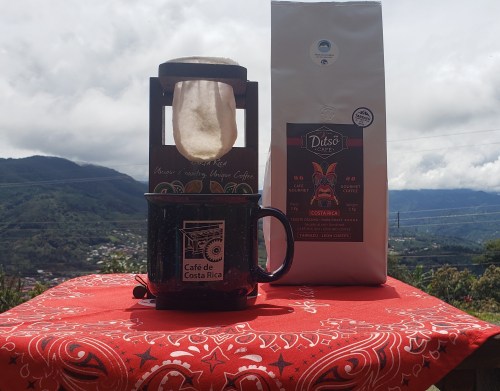Our editors independently select these products. Making a purchase through our links may earn Well+Good a commission
After years of drinking coffee on the reg, prepping a daily cup of joe often becomes a deeply personal (and, honestly, spiritual) experience. Whether you like your coffee black, spiked with cinnamon, or served with a splash of creamer, concocting the perfect morning brew varies from person to person. One thing that we can all agree on, however, is that few things compare to the first soul-soothing sip of coffee in the morning—ahhhh.
Experts in This Article
coffee producer at Ditsö Café
For Monserrat Prado Flores, a Costa Rican coffee producer at the fourth-generation, family-owned, and woman-led company Ditsö Café, preparing coffee is certainly a sacred everyday routine. And although innovation in the coffee industry has threatened this centuries-old method, Flores affirms that using a Costa Rican chorreador is one of the most special ways to make a perfect cup. Here, she shares how to use this simple tool, why it’s so important to Costa Rican natives, and some of the most important things to keep in mind when brewing with a chorreador.
What is a chorreador?
Costa Rica, home of the Blue Zone region of the Nicoya Peninsula and some of the longest-living people on the planet, is also a major global exporter of coffee, accounting for over one percent of global production. Coffee, one of the best antioxidant-rich beverages linked to boosting your longevity, is a common drink consumed in this country throughout the day.

According to Flores, who is located in León Cortés, Costa Rica in a coffee region known as Tarrazú, making coffee requires special care and attention. Her speciality is in sustainably-sourced, small-batch, and high-quality coffee production, and she partners with roasters like NYC-based Bean & Bean to sell products like the Costa Rica Las Lajas Red Honey coffee beans.
One way of making coffee that is particularly special to Flores is using a chorreador. “This method always takes me back to my Costa Rican roots,” she says. A chorreador—which comes from the Spanish word chorrear, which means to drip or trickle—is a Costa Rican coffee-making device that has been a part of the culture and tradition in this Central American country since ancient times.
The non-electronic coffee maker has a wooden base with a small, suspended receptacle that holds a cotton cloth filter or bag secured with a metal ring and filled with coffee, like this one sold on Amazon. Water is poured into the bag, which slowly drips into a container or cup to make freshly-brewed coffee. “It’s a very basic and artisanal tool, but it works super efficiently and always yields delicious results,” Flores says.
The cultural significance of a chorreador
Although Flores says that using this traditional method for making coffee has slowly disappeared in some Costa Rican homes due to innovation in the coffee industry—like the surge in electronic machines that might be more convenient on the day-to-day—continuing to use a chorreador holds a special meaning to most natives. “The chorreador has a sentimental connotation for Ticos [an endearing term for Costa Rican locals] and is a reminder of childhood and, for me, the love of my grandmother,” Flores says. “It takes us back to visiting family that still lived in the countryside, special celebratory gatherings, and rainy afternoons with bread to soothe the cold weather. My grandmother would heat the water for the coffee over firewood and set up the chorreador with patience and care. It would fill the room with so many warming aromas.”
Not only is making coffee in this traditional method a nostalgic experience, but Flores also explains that it’s how some like to brew the drink to take on the go when heading to work (no cord necessary makes the chorreador is very handy for traveling). Additionally, she explains that Costa Ricans tend to make additional batches in the chorreador throughout the day—not just in the morning. According to Flores, while coffee is often brewed for breakfast to start the day, it’s also common in Costa Rica to brew another cup after lunch to help digest a heavy meal. And in the afternoon, a cup is often paired with a snack to give a little boost of energy to end the day.
Using a chorreador is better for the environment, too
In recent years, Flores says there’s been a reemergence of using this handy gadget in homes and cafes, as it’s easy to use, portable, and eco-friendly. “It’s a great way to make a super flavorful cup of coffee that’s the perfect balance of acidic, sweet, and the natural bean’s flavor profile without single-use materials like paper coffee filters,” she says.
Unlike a paper filter, the chorreador’s cloth filters can be used over and over again if washed and kept clean between brews. To best clean them, Flores recommends avoiding soaps that leave behind residue—boiling them in clean water will eliminate any traces of oils, she says. They should also be dried and stored in a bacteria-free environment, like the fridge in an sealed airtight bag.
How to use a chorreador
A few things to consider, according to Flores:
- Avoid boiling the water when brewing coffee—the ideal temperature is between 197 and 206 degrees Fahrenheit.
- Make sure the cloth bag is completely clean when infusing the coffee.
- The ideal strength ratio should be 1:15 or 1:16, which means that 16 grams of coffee would need 240 milliliters of water. However, know that this can vary depending on the individual’s taste preferences.
- Make sure to pour the water over the grounds slowly. The cloth bag is more porous than a paper filter, so adding water too quickly won’t yield the most flavorful extraction. However, don’t brew for over five minutes—anything longer can yield coffee that’s too acidic.
- Use medium-ground coffee.
- Using a scale and timer will help you nail the perfect pour, extraction time, and weight every time.
Flores says that there’s no one exact way to use a chorreador. Instead, each household has its own special method for brewing coffee using this tool. However, she says the most important ingredient, no matter the method, is the patience, love, and care that goes into brewing a quality cup of coffee.
Just another reason to drink coffee. As if we really needed it:
Sign Up for Our Daily Newsletter
Get all the latest in wellness, trends, food, fitness, beauty, and more delivered right to your inbox.
Got it, you've been added to our email list.











